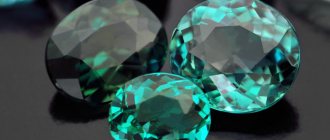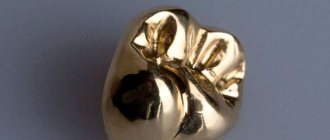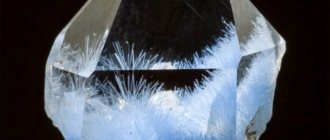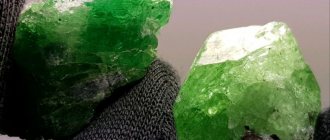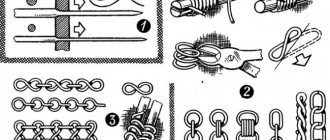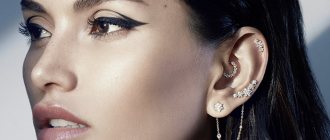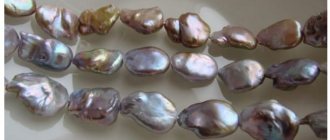| Category | Shellfish |
| Title in English | Pearl |
| Formula | CaCO3 |
| Group | Group of precious stones |
| Color | White, Yellowish, Silver, Golden, Cream, Blue, Green, Black, Grey, Pink |
| Stroke color | White |
| Shine | Pearl |
| Transparency | Translucent, Opaque |
| singonia | Fine-crystalline aggregates |
| Hardness | 3 — 4 |
| Cleavage | Absent |
| Density, g/cm³ | 2,6 — 2,78 |
| Kink | Shellish |
| origin of name | The definition of “pearl” has two versions of the name: European and Slavic. According to the first, the word was formed from the Chinese zhen-zhu, which translates as “real pearls.” By the way, despite the literal name, in the Celestial Empire pearls were closely associated with dragons. It was believed that the mineral fell from the sky during the battle of these mythical beasts. The Russian version of the name for this mineral has ancient Russian roots and is written as zhnchug. This term was first recorded on the altar cross of Euphrasinya of Polotsk. The cross was made to order from the Polotsk master Lazar Bogshey in 1611. It is believed that the word zhnchug was formed due to the transition of the Chinese word zhen-zhu into the ancient Chuvash language, where it took the form ǯinǯü. The English version of pearl is used in different variations by many European countries. For example, in France it is perle, and in Italy it is perla. The word pearl itself takes its roots from the Latin language. However, there is a discrepancy as to which word it comes from. In the first version, it was the word pernula, which refers to a type of marine bivalve mollusk. Another version uses the word pirula, which translates as “small pear.” Perhaps the comparison came from the appearance of irregularly shaped baroque pearls. |
| Morphology | Pearls are small, often irregularly shaped balls that are taken from the shell of mollusks. It is rare to find perfectly round minerals. |
Pearl deposits
The formation of pearls is characteristic of the shells of some river and sea mollusks.
Saltwater pearls are mined mainly in the waters of the Red Sea and the Persian Gulf, along the coasts of Sri Lanka and Japan. Freshwater pearls are mined in countries such as Germany, Russia, China and North America. The main source of pearls is bivalves. Representatives of the unionid family of the genus Margaritifera (European pearl mussel) and Dahurinaia (Daurian and Kamchatka pearl mussels) are known from freshwater, and from the sea – the genus Pinctada and the giant tridacna.
— Advertising —
A pearl is formed when mollusks react to irritation when a foreign body gets between the shell valves and the mantle or inside the latter. At the same time, its shape can turn out to be very diverse, both regular spherical and unusual - it all depends on the specific place of formation.
One mollusk shell can contain several dozen pearls. And, for example, Black Sea mussels sometimes include more than a hundred. But the more pearls, the smaller their size.
History of pearls
The term “pearl” is of Turkic origin and its etymology is not fully understood.
But the name of pearls, common in Europe, comes from the Latin “perna”, which means a type of marine bivalve mollusk, which in turn formed the basis of the Italian word “perla”, that is, “pearl”. The latter was borrowed into German, French, Polish, Russian, and Ukrainian languages. According to another version, the term “perla” goes back to the Latin “pirula”, that is, “small pear”. Pearls have been known to man since ancient times. It was mentioned in the Indian Vedas and on Persian clay tablets. Information about pearl mining in the Gulf of Mannar dates back to the 2nd century AD. The oldest known pearl jewelry is a necklace that was discovered in Susa in the early 20th century. A bronze figurine of Aphrodite that dates from 500 to 150 BC. was decorated with earrings with pearls in a gold frame. According to legend, Queen Cleopatra had the two largest pearls in the world.
Cotton pearl
Cotton pearls are made from pressed cotton and a pearl coating (pearl varnish), so they are much lighter than cultured pearls and much cheaper. A distinctive feature of such pearls is their rough surface. Cotton pearls have been produced in Japan for more than 50 years; they were very popular in the Land of the Rising Sun in the 40-50s of the last century. This is a very successful imitation of pearls: any color, size, shape (round or baroque). These pearls can be used to make multi-layered and voluminous necklaces, earrings, and bracelets. These products are easy to wear. There is only one significant drawback - they are not waterproof. It is better for jewelry made of cotton pearls not to come into contact with perfume; it can only be wiped with a dry cloth. If it is dirty in some places, it is advisable to replace the beads. The product should be handled carefully also because it is quite fragile - the beads are light, delicate and subject to deformation, even if you press hard with your finger. Currently, cotton pearls are made in Japan, China, South Korea, and Thailand. JAPAN CO., LTD. is the most famous bead and cotton pearl company in Japan. For the curious, the company website: https://www.miyuki-beads.co.jp/english/products/PartsPage/CottonPearl.html https://www.miyuki-beads.co.jp/english/project/index.html - click on any photo - Download PDF - product creation diagram
Physico-chemical characteristics of pearls
The pearl consists of three layers: periostracum (outer organic), middle and inner (nacreous).
They are based on calcium carbonate. The shape of the pearl varies from completely irregular to perfectly spherical. The hardness of pearls on the Mohs scale is 3.5-4. Specific gravity 2.61-2.69. It is opaque and can be painted in different colors.
What is special about the Cortez pearls?
Unlike other types of pearls, Cortez spheres can have not only a blue, but also a red overtone, which is generally unusual for mother-of-pearl formations. This feature is associated with the properties of the water in which the mollusk lives. Beautiful blue and dark blue pearls are not refined or painted. They are completely natural and, apart from washing and drying, are not subject to any other types of processing.
Average pea size: from 8 to 14 mm. The pearlescent layer reaches 2.2 mm.
Types of pearls
There are three types of gem quality pearls:
- Freshwater, which is produced in reservoirs of countries such as Russia, China, Germany, North America.
- Southern sea pearls (Australia, Philippines, Myanmar, Polynesia and Indonesia).
- Akoya Pearl (Japanese waters).
Fossil pearls are considered a separate type of pearl. It is extremely rare, and was first discovered only at the end of the 20th century in the Gobi Desert. Its peculiarity lies in its large core, which is approximately half the diameter of the pearl.
PEARL VARIETIES AND THEIR DIFFERENCES
The configuration, color and size of cultured pearls depend on the type of pearl oysters and their origin.
Biwa
Freshwater Baroque Nucleated Pearls. It was bred in Japan on Lake Biwa of the same name, but after the lake was polluted, the main production was moved to China.
We recommend: BALTIC AMBER mining for private owners
| Configuration | oblong or oval with an uneven surface |
| Color | milky, cream, grey, blue, pink, green, black, chocolate |
| Size | 6-12 mm |
Keshi (caches, keishes)
Nucleated Baroque pearls with a high luster, predominantly of marine origin. They are a by-product of pearl production and appear when the pearl mussel rejects the implanted nucleus.
| Configuration | granular or petal-shaped |
| Color and size | varied and depends on the type of mollusk |
Akoya (Akoya)
The first pearl grown by Kokichi Mikimoto. It belongs to the marine species and is distinguished by a relatively thin layer of mother-of-pearl. AAA-AAA category pearls are often found. Produced in Japan, China, Australia and Vietnam.
| Configuration | spherical |
| Color | white or cream with golden, pink or greenish hues |
| Size | 2-11 mm, but 6-8 mm is common |
Kasumi (Kasumi)
Baroque freshwater pearls with a core and a thick layer of nacre. Genuine Kasumi is grown only in Lake Kasumi-ga-ura in Japan. However, in China they have learned to create pearls with similar characteristics (Kasumi-like).
| Configuration | spherical |
| Color | milky or brown pearls with rainbow tints |
| Size | 9-13 mm |
South sea pearls (South Sea)
A popular type of large sea pearl, the largest beads of which grow up to 20 mm. It has a thick pearlescent layer and grades AA and AAA.
Pearls are expensive, since oysters are picky about environmental conditions and produce only 1 pearl in their lifetime.
Most of the farms are located in the Philippines, Australia and Indonesia.
| Configuration | spherical |
| Color | white silver, gold |
| Size | 10-13 mm |
Tahitian (Tahiti)
Large dark sea pearls with a thick layer of mother-of-pearl. Products with it are expensive, since due to the variety of shades it is difficult to select identical pearls for a set. AA and AAA grade beads appear frequently.
Despite the name, this type of pearl is not produced in Tahiti (the main trading bases are located there), but in French Polynesia.
| Configuration | spherical |
| Color | black, grey, brown, green with a wide variety of shades, distinguished by a steely sheen unusual for sea pearls |
| Size | 9-15 mm |
The magical properties of pearls
The magical abilities of pearls are aimed at bestowing happiness and success on their owner. They become especially good helpers for strong-willed and spiritually developed people. In addition, it is believed that pearls protect against evil eyes, deceptions and scammers, help balance the rhythm of life and give it harmony with nature.
The healing properties of pearls
Pearls contain a fairly large amount of calcium, which determines their healing qualities. All methods of its use in lithotherapy are based on getting its constituent elements into the body. For example, the Chinese made a special powder based on pearls, which they used to rub into the skin. There are methods according to which it is necessary to keep pearls in acidic water, and then drink this water.
Letter classification
- Quality D is the lowest for pearls. This rating is given to weakly shiny stones with numerous visible defects occupying more than 2/3 of the surface.
- Quality C - good gloss and the number of defects up to 2/3 of the surface.
- Quality B - small but visible defects occupy up to 1/3 of the surface, which has good gloss indicators.
- Quality A is the highest quality pearl. A surface without visible defects, allowing minor damage (no more than 10%) and having good reflective properties.
As a rule, jewelers do not use quality D and C pearls in jewelry.
Industries where pearls are used
Pearls are the only jewelry material that is formed in the bodies of mollusks, and one of the oldest among those used as jewelry. It does not require additional processing. For a long time it was valued very expensively and was considered a top-class material. However, methods have been developed for producing artificial pearls, which have become no less popular on the market than real ones. Artificial pearls are widely used in the manufacture of costume jewelry; they are very diverse in characteristics and are affordable.
Pearls of Cortez: unique cultivation examples
Of the few varieties of genuine blue pearls that can be cultured, Cortez is the most unusual. In reality, its name sounds like this - Sea of Cortez pearl, which means “pearls mined in the Sea of Cortez.” Amazing mother-of-pearl formations of unusual colors were discovered by the Mexicans.
Pearls became known to the world thanks to the conquistador Cortes, after whom they are still named. At the beginning of the 16th century, he brought magnificent examples of blue and gray colors as a gift to the Spanish king. After this, for several hundred years, people mercilessly lifted shells from the bottom of the sea by the thousands in search of rare pearls. The ban on hunting was announced only in 1939. It was then that the Mexican government decided to preserve the rapidly dying population.
Amazing blue, gray and blue pearls have returned to the pearl market thanks to the owner of the cultivation farm, Douglas McLarin. In Mexico and throughout America, he is the only owner of a farm where pearls are grown in the oyster Pteria Sterna and Black-Lipped Oyster, achieving the creation of a “harvest” of a completely unique color.
The most characteristic colors of Cortez beads are steel gray and blue with rainbow overtones. There are samples with overtones:
- pink;
- purple;
- green;
- lilac;
- raspberry.
Such combinations make the farmer’s creations recognizable and in demand in America and around the world. It is easy to distinguish the Cortez beads from the black heritage of the island of Tahiti. Each colored pearl glows with a pink-red hue when exposed to UV rays, with the exception of white beads with a blue glow. Dark pearls from the island of Tahiti do not emit light when exposed to ultraviolet light, maintaining their primary color.
Artificial pearls
The first pearl imitations were made of glass.
In the 15th and 16th centuries, the so-called “Roman pearls” were created, that is, glass beads filled with paraffin. “Pearl essence” was made from fish scales, which was used to cover such a ball and bake it in the oven several times until a characteristic mother-of-pearl shine was obtained. In the 20th century, “pearl cores” coated with varnishes appeared in the United States. At the same time, the industrial cultivation of pearls began using the so-called nuclear method, which was patented by the Japanese K. Mikimoto. It consisted of artificially introducing an irritant into the mollusk to stimulate the formation of a pearl. Today it remains popular and widely used.
VARIETIES OF PEARL BY TYPE
Natural pearls are divided into types:
- by place of formation - marine/freshwater;
- according to the living conditions of the mollusk - natural (wild)/cultivated.
Natural natural
Until the 19th century, pearl fishing consisted only of catching shellfish in the wild. The process itself was complex and life-threatening - the catchers dived to great depths, holding their breath for a long time.
Also, with the traditional method of mining, it was necessary to check a large number of shells before finding even one pearl. This led to the massive destruction of shellfish and environmental deterioration (shellfish are natural water filters in nature).
Harvesting pearl mussels in the wild has been officially prohibited worldwide since 1952.
Today natural pearls are obtained from:
- purchasing antiques;
- accidentally finding pearls in edible shellfish;
- through poaching.
There are pearls of sea and river (freshwater) origin.
Sea pearls
Sea pearls are more expensive due to their characteristics and more complex extraction technology. Mollusks that live in the seas are demanding on weather conditions, temperature and water composition and produce 1-2 pearls from one shell.
Peculiarities:
- grows faster than river;
- large (average size 8-14 mm);
- spherical or rare baroque forms are often found;
- rich palette of colors;
- strong shine due to a thick layer of mother-of-pearl
Freshwater
River pearl mussels are less fastidious and produce up to 20 pearls. Therefore, river (freshwater) pearls are easier to obtain, and their price is an order of magnitude lower than sea pearls.
Peculiarities:
- harder than the sea
- small (average size 3-11 mm);
- the layer of mother-of-pearl is thinner;
- soft matte shine;
- the palette is narrower than that of the sea, but there are original striped and spotted colors;
- It is distinguished by a variety of configurations - only 2% of pearls are round in shape.
We recommend: How RED AMBER is formed
Cultured natural
Cultured pearls are also natural, so they should not be confused with artificial pearls.
Brooch with cultured pearls and rubies (1995), designed by Salvador Dali
Attempts at cultivation were made in ancient China. At that time, the production of pearl figurines of saints flourished. The items were briefly placed in the shellfish and then emerged covered in a thin, iridescent layer. Of course, the quality of mother-of-pearl was low.
The progress of pearl cultivation was mainly hampered by the low level of biological sciences - people simply did not understand why pearls appear in mollusk shells.
Only in 1893, the Japanese Kokichi Mikimoto created the first pearl farm, making a breakthrough in the field:
- cultivation has made it possible to program the shape, color and size of pearls - most manufacturers are constantly working to improve the breed of mollusks, rejecting those unable to create high-quality pearls;
- It became possible to engage in pearl fishing without harming the environment.
Externally, natural and cultured pearls are indistinguishable. The main difference between them is the way the foreign object enters the sink.
Cultured pearls are similarly divided into sea and river (freshwater) pearls, preserving the basic characteristics of each type.
Cultured pearls in Bali
Cultured pearls still have minor differences:
- otherwise they let light through;
- density is higher than natural;
- fluoresce more intensely in X-rays;
- When an electric current is passed through, they begin to rotate, while natural pearls remain at rest.
However, these features are discernible only with specialized equipment and do not affect the appearance of the pearls.
Artificial
Despite the massive cultivation of shellfish, high-quality pearls are still an expensive pleasure. Therefore, as technology develops, people come up with new cheap analogues.
Main methods of imitation:
| Materials | Peculiarities | Differences from pearls |
| Glass | Glass is the very first material for imitation pearls:
|
|
| Plastic | The most popular method of imitation due to the variety of technologies and low cost of production. |
|
| Surface painting | Allows you to achieve maximum similarity to the original:
|
|
| Artificial improvement of the properties of natural pearls | Some manufacturers and suppliers artificially improve the appearance of low-quality pearls by:
|
|
How to distinguish real pearls from fakes
The most well-known way to distinguish artificial pearls from real ones is to run them along the surface of the teeth.
Only a true pearl makes a creak in this case. In addition, a fake made of plastic will be very light, the surface of glass will be too smooth, and the color, when magnified, will be uneven and spotty.
It should also be taken into account that in order to refine low-quality pearls, they are tinted or irradiated. Lapis and other dyes are used for coloring. In this case, the coloring often turns out spotty and uneven. After irradiation, the pearl becomes black with a metallic sheen.
How to care for pearls
Due to their organic origin, pearls are quite short-lived.
It swells in water, and when it dries, it crumbles and disintegrates. It is poorly affected by acids and cosmetics. Under their influence, color and shine are lost. Pearls gradually age, their “life” is about 100-150 years. In order to preserve its beauty, the stone is cleaned with salt water at least twice a year. If the pearl has lost its shine, then you can dissolve the top layer in acid and get a beautiful stone again.
WHAT COLORS ARE PEARLS IN NATURE?
The color spectrum of pearls includes 120 different shades. When evaluating a pearl, the colors are taken into account along with the shape and size.
The best natural pearls have no color and look snow-white. Thanks to its translucency, it has a soft silvery sheen and barely noticeable shimmers with the colors of the rainbow in the light.
Earrings made of natural white pearls 8 mm, 500 USD
The value of multi-colored pearls is determined depending on the purity and rarity of the color.
The most expensive pearls are blue, lilac, pink, gold and black of good saturation.
Natural pink and orange pearls from 3.3 mm to 13 mm
What determines the color of pearls
The appearance of white and colored pearls is determined by the following factors:
- type of mollusk;
- degree of transparency of the mother-of-pearl layer - the more transparent it is, the lighter the pearl;
- color of the organic layer under the mother of pearl;
- concentration of pearl aragonite and conchiolin in the shell - aragonite is colorless or white, and conchiolin has shades from to black;
- saturation and composition of impurities of chemical elements in water.
Jewelry classification system
The jewelry industry uses the following gradation of pearls:
| Quality | Shine | Defects | Selection of beads in the product | Configuration | Mother of pearl thickness |
| AAA | great | 95-99% absent | excellent | spherical | thick |
| AA+ | great | 90-95% are absent | excellent | spherical | thick |
| AA | very good | 80-90% are absent | very good | spherical | medium to thick |
| A | good | minor | good | close to spherical | average |
| B, C | Pearls with surface defects or low luster are practically not used in the jewelry industry. The exception is valuable types of baroque and semi-baroque. | ||||
Pearls and zodiac sign
Pearls are ideal for Pisces, Cancer and Aquarius.
Light samples are good for Gemini; Scorpios and Capricorns will establish relationships with black and gray pearls. It is not recommended for Leo, Aries and Virgo. Representatives of other zodiac signs can wear jewelry with pearls without fear.
Advice from astrologers
Although mother of pearl is an organic compound, it is not recommended for all zodiac signs to wear it.
Pearls suit your horoscope:
- Pisces.
- Aquarius.
- Cancer.
For Pisces, whose element is water, a cream or pink pearl will be a wonderful talisman. Representatives of this sign have an entrepreneurial spirit; they can open a business, develop it and succeed in business. Mother of pearl will help Pisces realize their ambitions and achieve success in business.
Aquarians can wear pearl beads every day. For representatives of this sign, jewelry will bring success in business and help cope with emotions and tension. Aquarians do not like to take responsibility and often withdraw into themselves. Mother of pearl will help them open up, find new friends and cope with important tasks at work.
Cancers find it difficult to realize their potential. Representatives of this sign are prone to creativity. They have a hidden talent that they may not even be aware of. Blue pearls will help Cancers find themselves, unlock their potential and realize it, enjoy what they love and get rid of negative emotions.
As for the rest of the zodiac signs, who is mother of pearl suitable for and who is not?
- Aries, whose element is fire, should not wear pearls, especially if they are gray, black or blue.
- Mother of pearl is also not suitable for virgins, whose element is earth. The restriction applies to pearls of any color.
- Leo is a bright representative of the element of fire; its representatives are subject to restrictions on wearing pearls. But for Leo, astrologers are not as categorical as for Virgo.
- White and cream pearls are ideal for Gemini, whose element is air.
- Scorpio, a sign of the water element, is suitable for gray or black pearls, as is Capricorn, whose element is earth.
- But for Taurus, Libra and Sagittarius, any pearls are suitable. Representatives of these signs can safely wear mother-of-pearl every day.
But not only magicians and sorcerers used pearls in their practice. Healers also had a certain love for mother of pearl.
Prices for pearl products
A sea pearl bead or necklace is valued at $450. If the beads are uneven or irregularly shaped, the price is reduced to $250. Pearl bracelets cost about $100. A silver ring with one pearl can be purchased for 15-20 dollars. The cost of freshwater pearls is usually half that.
Form
The shape of a pearl directly affects its price. A pearl with a more regular spherical shape is valued more expensive. Slight irregularity, when the pearl is elongated or flattened at the poles, significantly reduces its value.
There are three main shapes of pearls: spherical, symmetrical and baroque. The spherical shape is the least common in nature, which is why it is more expensive. Symmetrical pearls include slightly oblong “rice” type pearls, flattened to , and teardrop-shaped pearls, which are much cheaper than their spherical counterparts. Baroque pearls have an irregular shape, which is why they are the cheapest. However, these days the fashion industry is actively stimulating buyers' interest in baroque pearls, including them in their collections. Therefore, at present, the price of Baroque pearls is reaching unprecedented levels.

